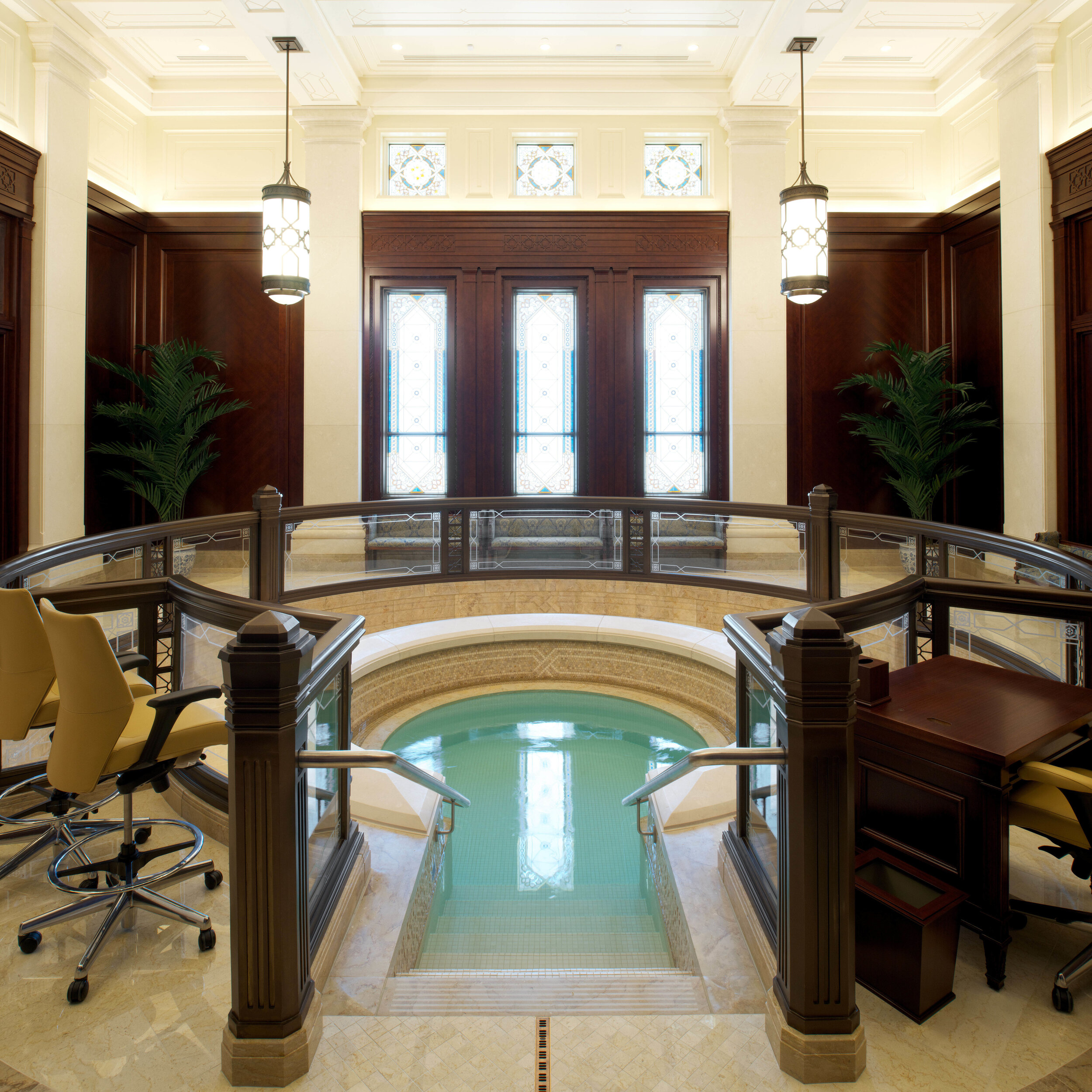The opening of the Indianapolis Temple in August 2015 was a milestone for Hoosier Latter-day Saints and a thrill for my IUPUI “Mormonism and American Culture” students, who were able to tour the temple during the public open house. For me, it was special honor to have as our guide my friend Paul H. Sinclair, an Area Seventy and chairman of the local temple committee.
I’m not a Latter-day Saint, so it was my first time inside an LDS temple, which is normally open only to church members holding a temple recommend, or proof of having met the requirements for participation in temple ordinances.
The most remarkable of these ordinances is baptism for the dead. In the temple’s baptistry, living members of the church are baptized as proxies (stand-ins) of people who died before the founding of the LDS Church or who, for other reasons, were never exposed to Mormon teachings. The living person is immersed in water and baptized according to the biblical formula (“in the name of the Father, and of the Son, and of the Holy Ghost”) on behalf of the dead person. Church members may be baptized for several people on the same day, repeating the ritual each time. Latter-day Saints do not believe that the ordinance makes the dead person a Mormon but simply gives him or her the opportunity to accept the baptism in the afterlife. This is why Mormons are so interested in genealogy—to identify as many of their ancestors as possible for vicarious baptism.
I have long thought the early Protestants made a mistake in rejecting sacraments for the dead. In their excessive zeal to root out Catholic “superstition,” Protestants repudiated masses offered for the souls in purgatory. Masses for the dead were so common in medieval religious practice that some priests were occupied with little else. As the historian Eamon Duffy has put it, “Catholicism on the eve of the Reformation has been described, with pardonable exaggeration, as a religion of the living in the service of the dead.”
One does not have to believe in a literal purgatory to realize that something was lost when Protestants cut the dead off from sacramental practice of the living. Duffy, an Irish Catholic, has written movingly of how prayers for the dead knit the living and the dead together in a common communion. “Prayer for the dead is neither fear nor fire insurance,” he writes, but rather “an exercise in the virtues of faith and hope and love” and “a bridge across the gulf of separation which is death.”
A bridge across the gulf of separation is exactly what Latter-day Saints achieve in the temple work they perform for the dead. And they have the Bible on their side. A passing reference by the Apostle Paul in 1 Corinthians 15:29 reveals that some members of the ancient Christian community at Corinth practiced a ritual of baptism for the dead (“Else, what shall they do which are baptized for the dead, if the dead rise not at all?”). The Corinthian rite does not appear to have caught on widely. The early church father Tertullian admonished readers to “never mind that practice (whatever it may have been),” and until the nineteenth century, most Christians ignored the disputed verse.
But in an 1840 funeral sermon, the Prophet Joseph Smith returned to 1 Corinthians 15:29 and soon thereafter reinstituted the practice of baptism for the dead. Today, the LDS scriptures contain an astonishing revelation, given at Nauvoo in 1842, in which the prophet elaborated the logic of the ordinance, arguing for a holy interdependence between the living and the dead: “For we without them cannot be made perfect; neither can they without us be made perfect” (D&C 128:18).
It’s a beautiful expression of mutuality, and one that deserves to be more widely known outside of Mormon circles. Within Protestantism, prayers or rituals for the dead remain mostly absent.
One exception from my own Episcopal tradition is the Eucharistic petition for the faithful departed that reentered the Book of Common Prayer in 1928 (and was preserved in Rite I of the 1979 BCP): “And we also bless thy holy Name for all thy servants departed this life in thy faith and fear; beseeching thee to grant them continual growth in thy love and service, and to give us grace to follow their good examples, that with them we may be partakers of thy heavenly kingdom.”
By remembering the dead sacramentally, we give thanks for them and acknowledge the claims they still make upon our lives. We also acknowledge the reality, as Duffy puts it, that “death leaves unfinished business—damaged and damaging relationships, misunderstandings unresolved, words of love or apology or explanation unspoken, the need to forgive, and to be forgiven.” He concludes: “What are we to do with such pain and incompleteness, but place it in the hands of God?”
Among the diverse Christianities of the world, Mormonism offers the boldest answer to the problem of our unfinished business with the dead. In defiance of death, Latter-day Saints declare that no persons—not even our far-distant ancestors—lie beyond the church’s sacramental intervention.
© 2021 by Peter J. Thuesen. All rights reserved
Further Reading
Eamon Duffy, “Praying for the Dead,” in Faith of Our Fathers: Reflections on Catholic Tradition (London: Continuum, 2004).
Terryl L. Givens, Feeding the Flock: The Foundations of Mormon Thought: Church and Praxis (New York: Oxford University Press, 2017).
Massey Hamilton Shepherd, The Oxford American Prayer Book Commentary (New York: Oxford University Press, 1950).

